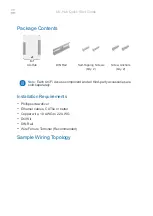
DSE Model 5510 Autostart Control and Instrumentation System Operators Manual
057-015 5510 OPERATING MANUAL ISSUE 11 07/07/09 AM 75
16.6 IEEE C37.2 STANDARD ELECTRICAL POWER SYSTEM DEVICE
FUNCTION NUMBERS
The DSE 5510 contains many protection devices and functions, which are listed in detail in the
following sections.
Functions and protections provided corresponding to IEEE C37.2 (1996) system device numbers
are listed below.
.
Overall the 5510 is designated as 11 - Multifunction device and includes the following protections
and functions:
Device
Description
2
time delay starting
or closing relay
A device that functions to give a desired amount of time delay before or
after any point of operation in a switching sequence or protective relay
system, except as specifically provided by device functions 48, 62, 79, and
82.
3
checking or
interlocking relay
A device that operates in response to the position of one or more other
devices or predetermined conditions in a piece of equipment or circuit, to
allow an operating sequence to proceed, or to stop, or to provide a check
of the position of these devices or conditions for any purpose.
5
stopping device
A control device used primarily to shut down equipment and hold it out of
operation. (This device may be manually or electrically actuated, but it
excludes the function of electrical lockout [see device function 86] on
abnormal conditions.)
12 overspeed device
A device, usually direct connected, that operates on machine overspeed.
14 underspeed device
A device that functions when the speed of a machine falls below a
predetermined value.
15
speed or frequency
matching device
A device that functions to match and hold the speed or frequency of a
machine or a system equal to, or approximately equal to, that of another
machine, source, or system.
18
accelerating or
decelerating device
A device that is used to close or cause the closing of circuits that are used
to increase or decrease the speed of a machine.
25
synchronizing or
synchronism-check
relay
A synchronizing device produces an output that causes closure at zero-
phase angle difference between two circuits. It may or may not include
voltage and speed control. A synchronism-check relay permits the
paralleling of two circuits that are within prescribed limits of voltage
magnitude, phase angle, and frequency.
27 undervoltage relay
A device that operates when its input voltage is less than a predetermined
value.
30 annunciator relay
A non-automatically reset device that gives a number of separate visual
indications upon the functioning of protective devices and that may also be
arranged to perform a lockout function.
31
separate excitation
device
A device that connects a circuit, such as the shunt field of a synchronous
converter, to a source of separate excitation during the starting sequence.
32
directional power
relay
A device that operates on a predetermined value of power flow in a given
direction such as reverse power flow resulting from the motoring of a
generator upon loss of its prime mover.
46
reverse-phase or
phase-balance
current relay
A device in a polyphase circuit that operates when the polyphase currents
are of reverse-phase sequence or when the polyphase currents are
unbalanced or when the negative phase-sequence current exceeds a preset
value.
48
incomplete
sequence relay
A device that generally returns the equipment to the normal or off position
and locks it out if the normal starting, operating, or stopping sequence is not
properly completed within a predetermined time.
50
instantaneous
overcurrent relay
A device that operates with no intentional time delay when the current
exceeds a preset value.
51
ac time overcurrent
relay
A device that functions when the ac input current exceeds a predetermined
value, and in which the input current and operating time are inversely related
through a substantial portion of the performance range.




































